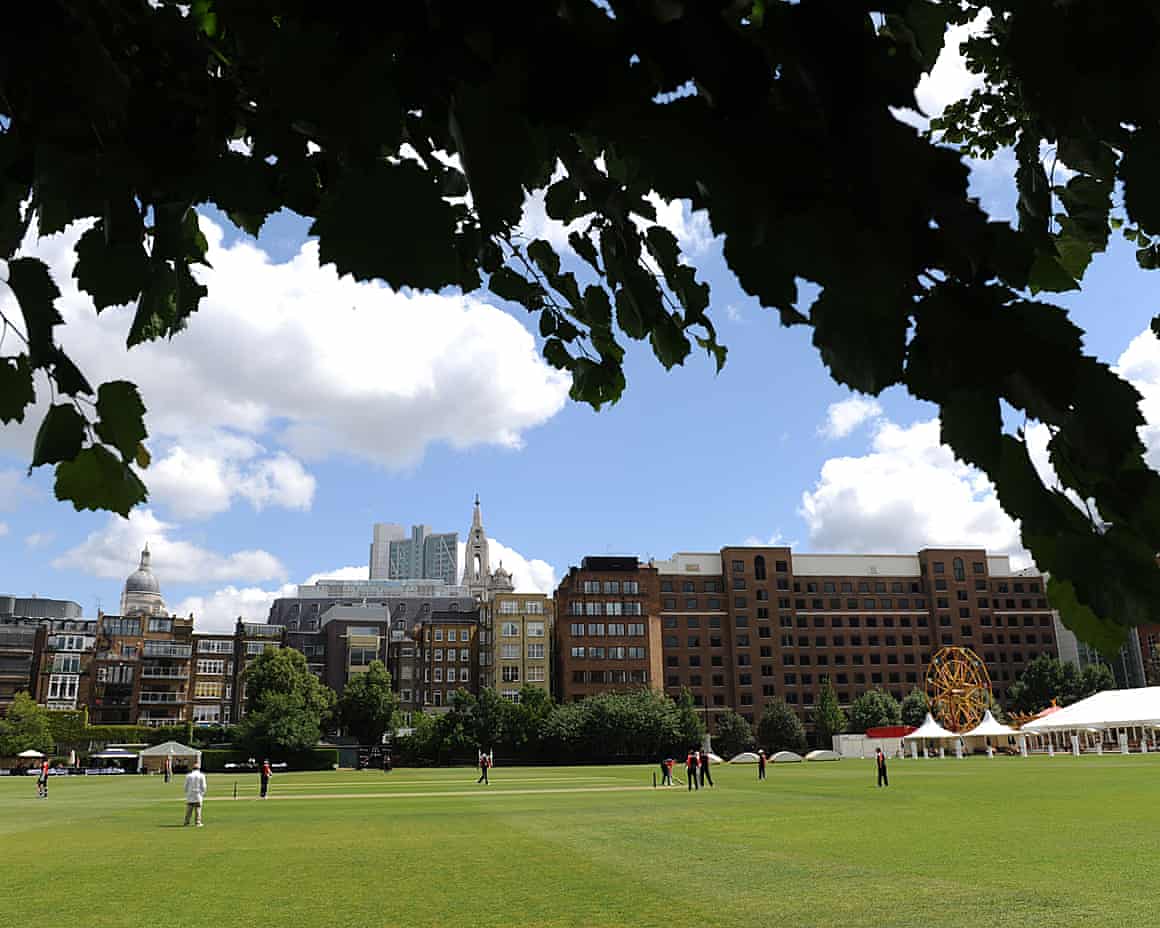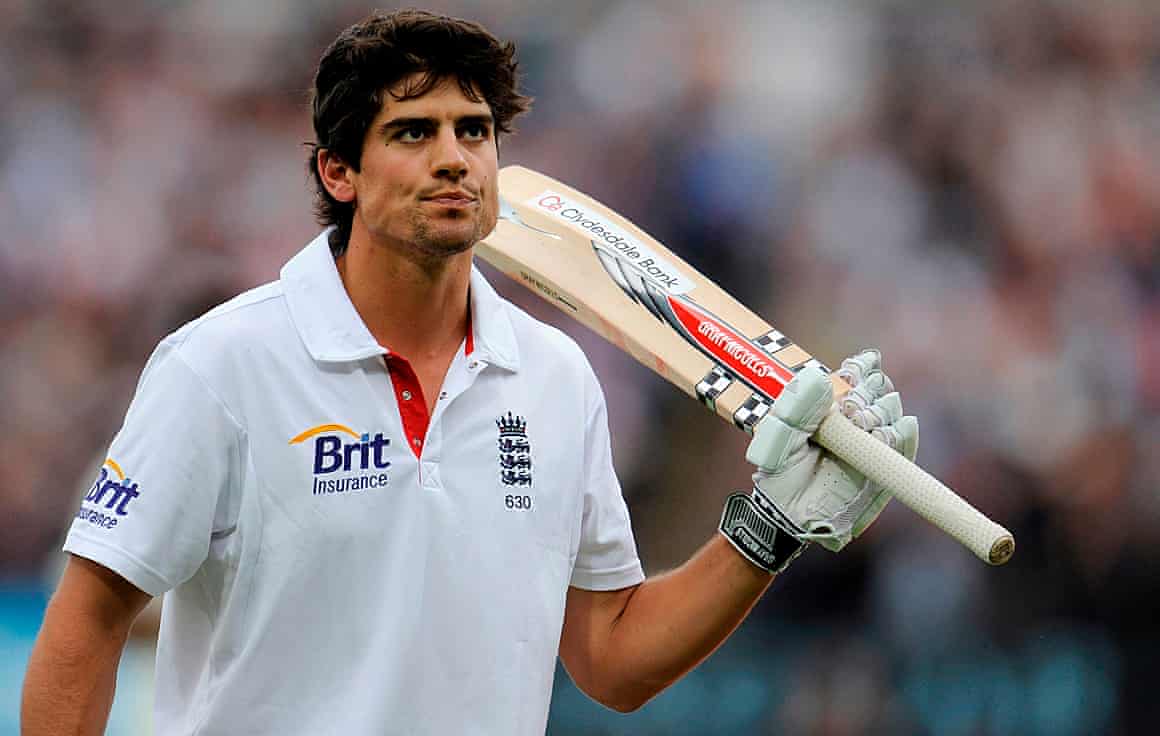|
Fund independent journalism
|
|
|

|
 |
|
|
‘Unlike any cricket ground in the UK’: the London oasis every player should visit
|
|
|
The HAC Cricket Club is rich in history and exemplifies the sport’s ability to endure upheaval and adapt
|
|
 |
 Surrounded on three sides by towering city buildings is the Honourable Artillery Company Cricket Club. Photograph: High Level/Shutterstock
|
|
 |
Daniel Gallan
|
|
|
|
You climb the stairs at Old Street Station, hauling a cumbersome cricket bag into the East London sunshine. The hipsters and creatives barely give you a cursory glance, presumably unaware of what lies just a five-minute walk away. Take the left bend on Old Street, veer down City Road, past some corner shops and the Bunhill Fields burial grounds where William Blake now rests, and there, through a black iron gate, you find an oasis.
Surrounded on three sides by towering city buildings is the Honourable Artillery Company (HAC) Cricket Club. The manicured pitches and lush green outfield stand out like a velvet rug draped over cold concrete. The pavilion is no mere clubhouse. It is a museum chronicling more than 300 years of history including the first recorded cricket match here in 1725, sweeping across three centuries of imperialism, conflict and sport.
|
|
|
|
|
|
|
|
“It’s unlike any cricket ground in the UK, probably the world,” beams Edward Haines, the club’s first XI captain and a former lance lance sergeant in the Territorial Army’s Artillery Reconnaissance regiment. “You never get tired of seeing people come across the ground for the first time. The look on their faces tells you how special this place is and how much history it holds.”
The ground boasts a number of cricketing milestones. On 2 June 1744 the Duke of Richmond assembled a team from Kent to take on a local London side. Instructions for attending the game were clear: “All persons that go out of the Ground during the match and intend to return again, are desired to take a Ticket, otherwise they will not be readmitted.” This marks the earliest known instance of punters needing a ticket to watch a cricket match. Kent’s 55-run victory is recorded in the sport’s oldest surviving scorecard.
The game’s popularity was clear. Two weeks later, when the Duke of Dorset arrived for a fixture against All England in a contest billed as “the greatest cricket match ever known”, spectators were charged a tuppence (two pence) to attend, the first time anyone had to pay to watch a game. Despite a “great disorder”, around 8,000 people were wedged around the ground and kept off the field under threat of a leather lash.
“We’re lucky if we get a dozen spectators watching us today,” says Haines, who has just completed eight matches in nine days in celebration of the club’s anniversary. “When I’m skipper, I’m too busy thinking about bowling changes and how to get the next wicket. But when I do stop and allow myself to contemplate the history of the place, it is quite extraordinary.”
The ground beneath Haines’ feet was once trodden by Edward “Lumpy” Stevens, who earned his nickname thanks to his ability to locate uneven bumps on the pitch with unerringly accurate underarm bowling. In a game in May 1775, the man regarded as cricket’s first great bowler proved unplayable to Hambledon’s John Small. Three times Stevens beat Small’s defence and bowled him through the gate. That would have been the end of things but for the absence of a middle stump. Following Small’s victory, regarded as an injustice by witnesses, the use of three stumps began to be commonplace before their use was codified in the laws of the game in 1785.
Cricket at the HAC was under threat towards the end of the 18th century as a result of unruly behaviour and clashes with military activities. It was only in 1846 – thanks to a sanction from HAC’s Captain-General, Prince Albert – that the sport was once again permitted “subject to regulation for ensuring the order and discipline of the Corps.”
Cricket has long been entangled with Britain’s colonial project. It was soldiers carrying bibles, bullets and bats who spread the game around the world. Matches were held in garrisons from Jamaica to Rawalpindi, often reinforcing imperial hierarchies. The sport was as much a performance of Englishness as it was a weapon of soft power.
|
|
|
 |
 A cricket match under way at the Honourable Artillery Company Cricket Club. Photograph: Shutterstock
|
|
|
|
Those imperial echoes remain visible at the HAC. Several large cannons look out over the field. Inside the pavilion are plaques honouring the deeds of British troops in the name of empire. The HAC’s first overseas deployment came during the Second Boer War in South Africa, a brutal imperial campaign in which six of its members were killed, as well as two Test cricketers: John Ferris of Australia and Frank Milligan of England.
Cricket at the HAC survived an enforced hiatus during the First World War when play was suspended. The pitch transformed into a mobile anti-aircraft station while the outfield was dug up for trench warfare training. Play resumed after the Armistice and continued through the second world war.
The HAC exemplifies cricket’s ability to endure upheaval and also the sport’s adaptability. “We now have a commonwealth of players,” says Haines, proud of his teammates from Africa, Asia and the Caribbean. “We don’t shy away from any uncomfortable strands of our history but we choose to celebrate what we have now and where we’ve come from. We’ve recruited people from around the world to the regiment and the cricket club has played a key role in that.”
Even in the shadow of empire, a cricket ground in East London can still be a site of joy, escape, and community. It may have once been a proving ground for soldiers. Now, it’s a stage for something far gentler. If nothing else, a game here should be on every player’s bucket list.
Booze and biltong at Lord’s
My favourite cricket book ever written is Mike Marqusee’s Anyone but England. Whenever someone refers to Lord’s as the “Home of Cricket” or talks about the “proper” way of playing I scoff and roll my eyes.
With those caveats out the way, here goes my double-think: All future World Test Championship finals should be played in England. There. I said it. Here’s why.
I was at Lord’s last month to watch – both as a fan and a journalist – South Africa’s historic triumph over Australia. It was a cracking game. There were 14 wickets on each of the first two days. Tails wagged, partnerships blossomed, bowling attacks looked almost otherworldly. It was a brilliant advert for a sport that, despite the naysayers, has never been more thrilling.
Beyond the boundary, Lord’s was a heaving, intoxicating mass of Saffas and Aussies. There was banter, booze and biltong. Wherever you looked there were retro replica shirts, straw hats and hugs between strangers. At times it had the carefree feel of a music festival where you’d bump into an acquaintance and embrace them as a long-lost bestie.
|
|
|
 |
 South Africa fans celebrate their victory over Australia in the World Test Championship final at Lord’s. Photograph: Ray Lawrence/TGS Photo/Shutterstock
|
|
|
|
Of course other countries are capable of producing something similar, but nowhere else in the cricket playing universe is as blessed with expats of all stripes. Loads of supporters travelled from Johannesburg and Sydney, but I’d bet the vast majority already call the UK home. If the next final is contested between Pakistan and West Indies there’d be a similarly healthy stock of fans around the corner from St John’s Wood.
Speaking to Wisden Cricket Monthly, Ravi Shastri argued that the WTC final should be rotated. This would make sense if every nation could guarantee a healthy crowd to watch what is billed as one of the sport’s flagship events. But would Indians fill the Wankhede Stadium if New Zealand and Sri Lanka were playing a one-off final? Would the Kensington Oval brim with fans if South Africa faced Bangladesh? I’m not convinced.
But in England, where even second division County Championship games on weekdays pull crowds rivalling some international Tests elsewhere, bums on seats would never be a worry. And if any future final can replicate the vibe that lit up Lord’s a fortnight ago, it would go down as an instant classic.
Quote of the week
I would want more. Because most of the money that’s generated comes from India. So it’s only fair that they get their share of pound of flesh” – Ravi Shastri, in the aforementioned chat with Wisden, suggested India’s share of all ICC revenue, currently at 38.5%, should increase.
Memory lane
As England and India meet at Edgbaston after an enthralling first Test series encounter at Headingley the mind goes back to Alastair Cook’s remarkable knock of 294 at the ground against their rivals in 2011. What was clear from Cook’s rueful look in response at getting out, despite the huge score, was his disappointment. As David Hopps reported at the time: Only Len Hutton has ever batted longer for England in a Test, but Cook still wanted more, admitting to a tinge of disappointment at not joining the elite band of batters who have made a triple Test hundred. “It’s mad, isn’t it, how you can still be disappointed when you score 290-odd,” he said. “Only cricket can do that for you. I’m really thrilled that I put a really big score together but there is a tinge of disappointment.”
|
|
|
 |
 Alastair Cook leaves the field after being dismissed for 294 during the third Test against India at Edgbaston in 2011. Photograph: Philip Brown/Reuters
|
|
|
Still want more?
A lot of the talk around the second Test at Edgbaston was about Jofra Archer’s call-up and the split between those who wanted him to start and others who were adamant he should be saved till the Lord’s clash. Archer, 30, was the standout name when an otherwise unchanged squad was announced.
England’s managing director Rob Key played down concerns about Jofra Archer’s readiness for Test cricket, insisting England could have fast-tracked his comeback sooner and saying he trusts Ben Stokes not to flog such a precious commodity, as Ali Martin reports here. And here’s Ali on what some are calling Bazball 2.0 after the Test victory at Headingley.
On the county cricket beat, Tanya Aldred was at York this week as Surrey set their record first-class score, finally putting Durham out of their misery at 820 for nine.
And Raf Nicholson at Trent Bridge witnessed England fall to their heaviest ever women’s T20 defeat, against India.
Contact The Spin …
… by writing to Daniel.
In?
To subscribe to The Spin, just visit this page and follow the instructions.
|
|
|
Advertisement
|
|
|
 |
|

|
Manage your emails | Unsubscribe | Trouble viewing?
|
| You are receiving this email because you are a subscriber to The Spin. Guardian News & Media Limited - a member of Guardian Media Group PLC. Registered Office: Kings Place, 90 York Way, London, N1 9GU. Registered in England No. 908396 |
|
|
|
|
|